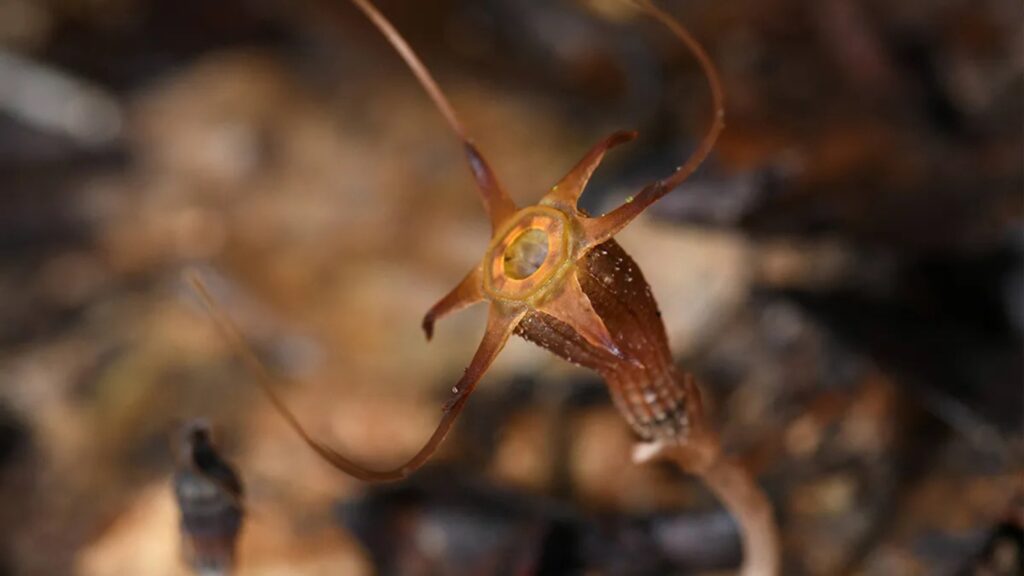With no leaves or chlorophyll, Thismia aliasii survives underground and flowers like a lantern—scientists say its fate is already at risk from rising ecotourism.
TERENGGANU, MALAYSIA — Deep in the dense hill forests of eastern Peninsular Malaysia, scientists have unveiled a botanical marvel that defies the typical rules of plant life. Meet Thismia aliasii, a newly discovered species from the elusive “fairy lantern” genus. Barely 11 centimeters tall, leafless, and devoid of chlorophyll, this strange plant relies entirely on underground fungal networks for its survival.
Published in the open-access journal PhytoKeys, the formal description of T. aliasii not only highlights its unusual biology but also its precarious conservation status. It is already listed as Critically Endangered, with only five individuals ever recorded despite multiple field surveys.
RELEVANT SUSTAINABLE GOALS


A Plant That Lives Without Light
Unlike most flora that depend on photosynthesis, Thismia aliasii thrives in complete darkness underground, surfacing only briefly with a striking orange-brown, lantern-like flower. It belongs to a rare group of mycoheterotrophic plants—organisms that parasitize fungi to obtain nutrients instead of producing their own food.
Its ethereal structure is not just a visual spectacle. The flower is believed to engage in highly specialized pollination, likely involving fungus gnats, in a hidden ecological dance that underscores the complexity of rainforest ecosystems.
“The discovery of Thismia aliasii is very interesting as it was found in a mountainous region known for its natural beauty,” said co-author Mohamad Alias Shakri, who first spotted the plant in 2019 during an expedition to Chemerong Forest Eco Park, a protected reserve popular with hikers and nature lovers.
Found by a Forest Ranger, Delayed by a Pandemic
Despite being located within a conservation zone, the plant’s path to discovery wasn’t straightforward. First noticed by Shakri, a ranger with the Terengganu Forestry Department, efforts to collect and study specimens were hindered by the onset of the COVID-19 pandemic.
“It was not easy to obtain specimens for further study as its habitat is on the mountain and COVID time delayed search efforts. Fortunately, targeted fieldwork to find this plant was successful with the support of NAGAO,” Shakri said, referring to funding from the Nagao Research Grant Foundation.
The study was led by Siti-Munirah Mat Yunoh of the Forest Research Institute Malaysia (FRIM) and supported by the Ministry of Natural Resources and Environmental Sustainability under the 12th Malaysian Plan.
Critically Endangered at Birth
Although it made a striking debut, Thismia aliasii faces immediate danger. Only five plants were found during multiple expeditions, and increasing mountaineer traffic is putting its delicate habitat at risk. Now listed as Critically Endangered by the IUCN, the species highlights how even newly found plants are vulnerable to extinction—especially in biodiversity hotspots under pressure from tourism and habitat disruption.
The discovery further cements Terengganu’s status as a global hotspot for Thismia diversity. The region is now home to at least 13 known species of the genus, including six that are endemic—found nowhere else in the world.
“This adds to Terengganu’s growing botanical heritage,” the authors note, “but it also raises the stakes for protecting these ecosystems, many of which still hold secrets beneath the soil.”
The lantern-shaped flower of Thismia aliasii appears for just a brief window each year, offering scientists only fleeting opportunities for observation. This mystery—paired with its rarity and unique biology—has captivated botanists, while also raising alarms about the fragility of forest ecosystems under human pressure.
With the dual forces of ecotourism and climate change encroaching on Malaysia’s ancient rainforests, T. aliasii serves as a poignant symbol: of beauty, of mystery, and of what may vanish before it’s even fully understood.
Lead image courtesy of Siti-Munirah MY, Mohamad Alias S. CC BY.
You may also be interested in :
Southeast Asia’s Alarming Primary Tropical Forests Loss Indonesia, Laos, And Malaysia Among Top 10




